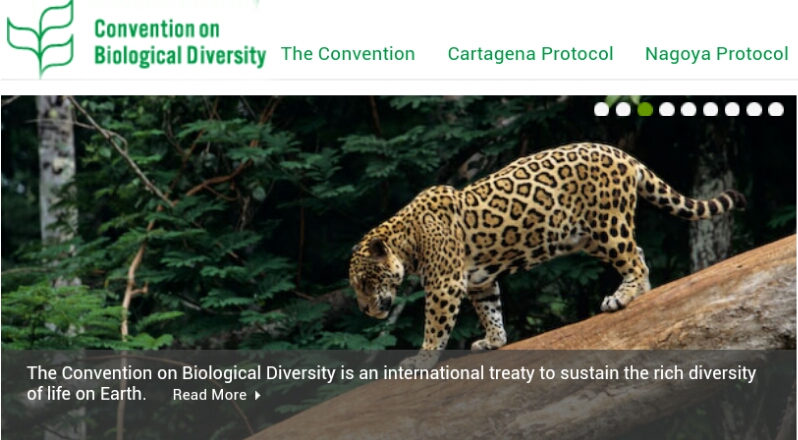The Convention on Biological Diversity (CBD) is an international convention for protecting the diversity of life on Earth. As opposed to treaties focusing on individual species or biomes, this international treaty encompasses biodiversity on a global scale. It focuses on establishing a global network of protected natural areas, for the purpose of protecting natural capital at the international level.
The CBD espouses a philosophy of sustainable use of Earth’s finite natural resources, recognizing that all ecosystems, species, and even genes must be protected and utilized for the benefit of all human beings. Utilization of these resources must be sustainable, not resulting in biological diversity declines. The convention recognizes that conserving biological diversity requires substantial investments from, and promises significant social, economic and environmental benefits for, all of mankind. Countries that join the CBD (‘Parties’) are legally bound to implement its provisions.
USA – Party Pooper Nonpareil
The European Union and 193 nation states are parties to the CBD. With the exception of the United States and Andorra, all United Nation member states have ratified the treaty. The Cook Islands and Niue are two non-UN member states that have ratified. The CBD entered into force for the latest party, South Sudan, on 18 May 2014. The Holy See and states with limited international recognition are non-parties. The US has signed the treaty, but with the overwhelming political pressure of Big Biotech in America (e.g., the 2013 passage into law of the Farmer Assurance Provision), unfortunately, it is unlikely that the United States will ever ratify this treaty. (Heavy sigh)
The Three Main Objectives Of The Convention On Biological Diversity
As early as 1995, the CBD adopted the ecosystem approach as the primary framework for addressing the three objectives of the Convention. These three objectives are, 1. Conservation of biodiversity; 2. Sustainable utilization of component species; and 3. Fair and equitable sharing of genetic resources and resultant benefits. It is sticky objective number 3 that the USA finds so unpalatable. Fair and equitable sharing is simply not a component of American Crony Capitalism.
The CBD objectives aim to develop strategies for the conservation and sustainable use of biological diversity at national levels for international benefit. In order to promote successful implementation of the ecosystem approach, parties, governments and relevant organizations are urged to submit case studies, lessons learned and technical information for the CBD Source Book. Parties are also encouraged to incorporate the ecosystem approach into poverty reduction strategies at local levels, allowing direct community participation.
2011-2020, The UN Decade On Biodiversity
2010 was declared the International Year of Biodiversity. On 22 December 2010, the United Nations declared the period from 2011 to 2020 as the UN Decade on Biodiversity, adopting the current recommendations of the CBD signatories.
Ecosystems Can Be “A Grain of Soil, a Pond, a Forest, a Biome or the Entire Biosphere”
According to the CBD, “‘Ecosystem’ means a dynamic complex of plant, animal and micro-organism communities and their non-living environment interacting as a functional unit. This definition does not specify any particular spatial unit or scale, in contrast to the Convention’s definition of ‘habitat’. Thus, the term ‘ecosystem’ does not, necessarily, correspond to the terms ‘biome’ or ‘ecological zone’, but can refer to any functioning unit at any scale. Indeed, the scale of analysis and action should be determined by the problem being addressed. It could, for example, be a grain of soil, a pond, a forest, a biome or the entire biosphere.”
Characteristics of the CBD Ecosystem Approach
The following statements are taken from the CBD description of the ecosystem approach:
“The ecosystem approach is a strategy for the integrated management of land, water and living resources that promotes conservation and sustainable use in an equitable way. Based on the application of appropriate scientific methodologies focused on levels of biological organization, it encompasses the essential structure, processes, functions and interactions among organisms and their environment. This approach recognizes that humans, with their cultural diversity, are an integral component of many ecosystems.
“The ecosystem approach requires adaptive management to deal with the complex and dynamic nature of ecosystems and the absence of complete knowledge or understanding of their functioning. Management must be adaptive in order to be able to respond to such uncertainties and contain elements of “learning-by-doing” or research feedback. Measures may need to be taken even when some cause-and-effect relationships are not yet fully established scientifically.
“The ecosystem approach does not preclude other management and conservation approaches, such as biosphere reserves, protected areas, and single-species conservation programmes, as well as other approaches carried out under existing national policy and legislative frameworks, but could, rather, integrate all these approaches and other methodologies to deal with complex situations. There is no single way to implement the ecosystem approach, as it depends on local, provincial, national, regional or global conditions. Indeed, there are many ways in which ecosystem approaches may be used as the framework for delivering the objectives of the Convention in practice.”
Applying the Ecosystem Approach
The ecosystem approach is a tool providing a framework for implementing the objectives of the Convention on Biological Diversity. There is no single correct way for applying the ecosystem approach to land, water and living resource management. The principles underlying the ecosystem approach are purposely flexible to address management issues in varying social, economic and environmental contexts.
Implementing the ecosystem approach can be as simple as including its principles in national and regional polices, planning processes and sectoral plans. Smaller projects may be more conveniently adapted to the ecosystem approach on local levels. The CBD website contains step by step guidance, from problem identification through to management plan and project implementation. The searchable component of the ecosystem approach sourcebook can be used to find information on case studies and tools which have met some or all of ecosystem approach principles.
There is much to be learned from the experiences of others when attempting to use the CBD ecosystem approach. Sharing lessons of successful implementation at all appropriate levels can reap rewards and benefits far outweighing the investment of time, money and manpower. Sustaining Earth’s finite natural resources through the unified efforts of the international community is a truly lofty goal, elevating mankind to a level of stewardship hardly believed attainable by previous generations. Fair and equitable sharing is surely the High Road to our success on Earth.




